

Red kuri squash, also called Orange Hokkaido and Japanese squash, is a delicious vegetable, fleshy and tasty.
Summary of Red Kuri facts
Name – Curcubita maxima
Family – Cucurbitaceae: gourd family
Type – vegetable
Height – 8 to 16 inches (20 to 40 cm)
Exposure – full sun
Soil – rich and well drained
Sowing red kuri squash: spring – Harvest: September, October, November
Easy to grow, they prefer rich soil and sunlit spots.
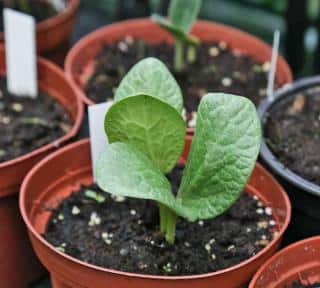 It is possible to start sowing during the month of March, in a sheltered place, or in mid-May directly in the ground. Red kuri squash is a frost-sensitive plant and you must ensure that the last frosts are past before transplanting them to their growing bed in the vegetable patch.
It is possible to start sowing during the month of March, in a sheltered place, or in mid-May directly in the ground. Red kuri squash is a frost-sensitive plant and you must ensure that the last frosts are past before transplanting them to their growing bed in the vegetable patch.
For areas with milder climates, the first seedlings can be started in the month of April.
If sowing in nursery pots in spring, count more or less 3 weeks before transplanting them to the ground. That’s why there is no need to sow early.
In a good soil mix:
It is also possible to sow directly in the ground, starting from the month of May.
You must pinch stems off regularly to stimulate plant growth, this will ensure better productivity.
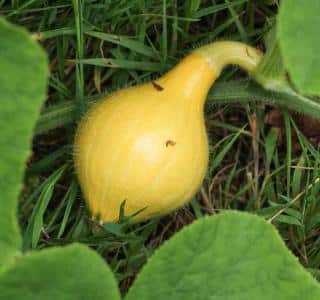 More branches will grow from the base: best keep a single fruit on each branch.
More branches will grow from the base: best keep a single fruit on each branch.
Once the plants have grown well, mulch their base to keep the soil moist and cool.
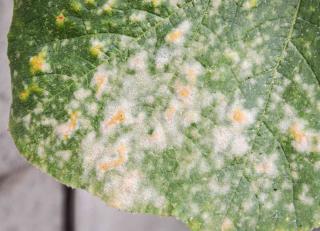 Water regularly in summer and avoid wetting the leaves.
Water regularly in summer and avoid wetting the leaves.
Other diseases include:
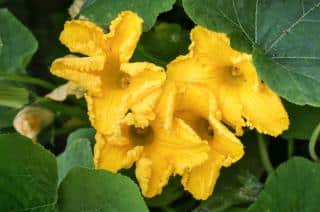 Red kuri, like all other squash, has both male and female flowers on the same plant. Male flowers tend to open and appear earlier. Female flowers open up a bit later.
Red kuri, like all other squash, has both male and female flowers on the same plant. Male flowers tend to open and appear earlier. Female flowers open up a bit later.
Only female flowers can set fruit. You can tell by checking the base of the flower: if there’s a bulge, it’s a female flower.
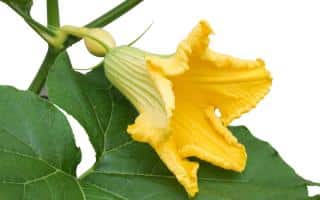 Pollinators normally do the work well, and most female flower set fruit naturally.
Pollinators normally do the work well, and most female flower set fruit naturally.
If you want to control pollination (for instance, avoid cross-pollination, or because many flowers dropped already), you can hand pollinate red kuri:
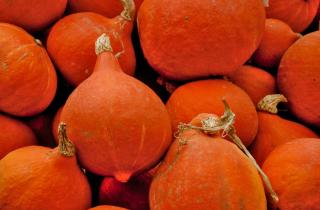 Harvest the red kuri squash as soon as leaves dry up and skin darkens.
Harvest the red kuri squash as soon as leaves dry up and skin darkens.
Fruits should start to mature as early as September, but best is to harvest your squash when the stem has dried up and foliage has turned yellow.
After the harvest, red kuri can keep for almost a year, in a dry room with a temperature ranging between 50 to 60°F (10 to 15°C).
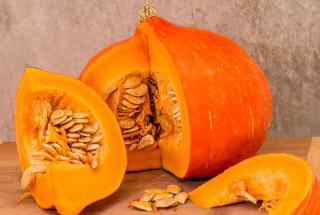 Dry the seeds and make sure all flesh is washed away.
Dry the seeds and make sure all flesh is washed away.Native to North America, red kuri squash usually boasts a brick-red color, but some may turn out yellow.
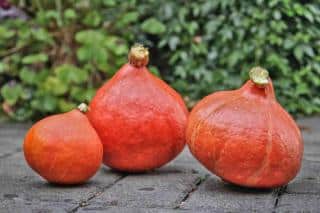 With high levels of vitamin A, B, C, D and E and trace elements (phosphorus, calcium, magnesium, potassium, sodium and iron), these fruits also have the advantage of keeping for a long time over winter, ideally at temperatures of about 50 / 55°F (10 / 12°C).
With high levels of vitamin A, B, C, D and E and trace elements (phosphorus, calcium, magnesium, potassium, sodium and iron), these fruits also have the advantage of keeping for a long time over winter, ideally at temperatures of about 50 / 55°F (10 / 12°C).
Since it contains 92% water, red kuri squash is low on calories and is potassium-rich, which makes it an excellent vegetable against hypertension. Its flesh has high levels of vitamin A, giving it antioxidant properties.
The different varieties of red kuri squash that are grown most are ‘Red kuri’, ‘Uchiki kuri’, ‘Akaguri’ or the ‘Potimarron français’.
Of course, another reason why the red kuri squash is very appreciated is because its sweet flesh reminds one of chestnut.
Unlike squash, you don’t need to remove the skin of red kuri squash before cooking.
Try growing red kuri vertically up a wall to maximize space in your vegetable patch!
Your comment is awaiting moderation.
Thank you so much for planting and pruning guide for red Kuri Squash! I was told by a farmer that Kuri squash was originally from Japan. Is that correct? Is that why purchasing kuri seeds is so expensive? I’m saving the seeds this year from one I bought from this farmer. Is their a correct way of drying them?
You’re very welcome! It is in deed native to Japan, and it’s sometimes called Hokkaido squash. The price, though, isn’t related to that, since most seeds are now produced anywhere.
It’s a very good idea to save the seeds from your red kuri. They’re true to seed, meaning they will for sure germinate and produce the same kind of fruits as the ones you got this year.
To dry them, just make sure all flesh was rinsed/washed away, and set them to dry on a cloth or paper towel, for about a week in a dry spot. Then, pack them in a paper envelope (not anything airtight because it might mold) and put the envelope in a cool, dark spot. Usually a crate with a lid in a garage is fine. Write the year on the envelope, because germination is always highest the first year.
Thanks so much, Gaspard’ I will do as you have suggested for saving the seeds. Sorry not to be able to send a picture. Kuri soup was delicious!
Thank-you for the really helpful details – I am growing them for the first time in my garden in Wales and now have a much better idea about what to do
That’s very nice of you to thank me for this! Please do feel free to share a few photos on the forum, it’ll be nice to follow your progress!
Very invasive. Once you taste it – you will never sow any other variety.
Very true! Laughed at the fact that for once, invasiveness is considered a compliment! Love the nutty flavor of that variety.
I have lots of male flowers but don’t see any females yet which produce the fruit.
Hello Anne, that’s actually quite common – and frustrating. It’s a clever strategy by the plant to attract pollinators at little cost: bearing male flowers doesn’t consume much energy, whereas female flowers require a higher nutrient load. So after attracting males for up to a few weeks, creating a habit for these pollinators, the plant will start sending out a few female flowers. There’s nothing much to do except wait!
Thanks for this information it’s really helpful, especially the pruning of the plant.
I’m also growing Crown Prince squash, do the same rules apply?
Yes they do, Chris, the same rules apply. They’re like brothers and sisters in the squash family, so you can follow the same advice exactly for Crown Prince.